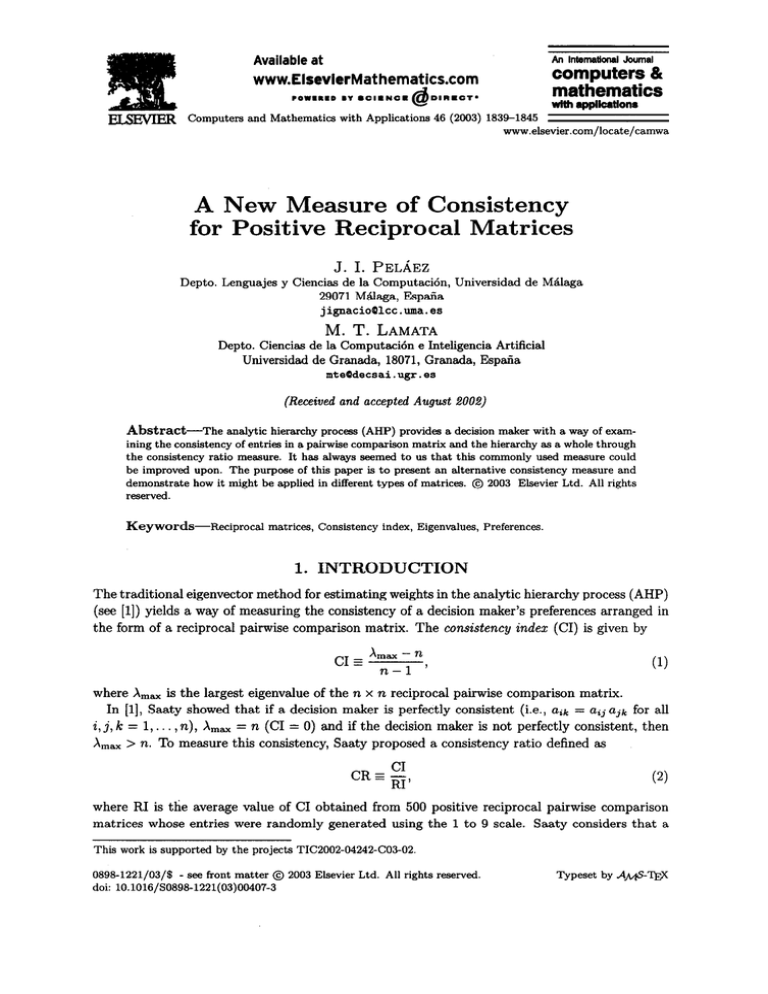
An IntematimlJournal
Available at
computers &
mathematics
www.ElsevierMathematics.com
with applicatlonr
m
Computers
and Mathematics
with
Applications
46 (2003)
1839-1845
www.elsevier.com/locate/camwa
A New Measure
of Consistency
for Positive
Reciprocal
Matrices
J. I. PEL~~EZ
Depto.
Lenguajes
y Ciencias
de la Computac%n,
29071 MQaga,
Espaiia
jipacioQlcc.uma.es
Universidad
de MBlaga
M. T. LAMATA
Depto.
Ciencias
Universidad
de la Computaci&
e Inteligencia
de Granada,
18071, Granada,
mteQdecsai.ugr.es
Artificial
Espaiia
(Received and accepted August 2002)
Abstract-The
analytic
hierarchy
process
(AHP)
provides
a decision
maker with a way of examining the consistency
of entries in a pairwise
comparison
matrix
and the hierarchy
as a whole through
the consistency
ratio measure.
It has always seemed to us that this commonly
used measure
could
be improved
upon. The purpose
of this paper is to present
an alternative
consistency
measure
and
demonstrate
how it might be applied in different
types of matrices.
@ 2003 Elsevier
Ltd. All rights
reserved.
Keywords-&ciprocd
matrices, Consistencyindex, Eigenvalues,Preferences.
1. INTRODUCTION
The traditional eigenvector method for estimating weights in the analytic hierarchy process (AHP)
(see [l]) yields a way of measuring the consistency of a decision maker’s preferences arranged in
the form of a reciprocal pairwise comparison matrix. The consistency index (CI) is given by
CIr
A-n,
n-l
(1)
where X,, is the largest eigenvalue of the n x n reciprocal pairwise comparison matrix.
In [l], Saaty showed that if a decision maker is perfectly consistent (i.e., aik = aij ajk for all
i,j,k = l,..., n), X,, = n (CI = 0) and if the decision maker is not perfectly consistent, then
X,,, > n. To measure this consistency, Saaty proposed a consistency ratio defined as
CR=:
(2)
RI’
where RI is the average value of CI obtained from 500 positive reciprocal pairwise comparison
matrices whose entries were randomly generated using the 1 to 9 scale. Saaty considers that a
This
work
is supported
by the projects
0898-1221/03/$
- see front matter
doi: lO.l016/SO898-1221(03)00407-3
TIC2002-04242-C03-02.
@ 2003 Elsevier
Ltd.
All rights
reserved.
Typeset
by dn,ts-m
1840
J. I. PEL~EZ
Table
1. Values
AND M. T. LAMATA
of the random
N
1 l-2
RI
I
0
index
for different
matrix
orders.
3
4
5
6
7
0.58
0.90
1.12
1.24
1.32
value of CR under 0.10 indicates that the decision maker is sufficiently consistent. Table 1 gives
values of the average RI for different values of n.
This consistency measure is a reasonable measure but, at the same time, somewhat arbitrary [2-71. Several questions come to mind.
(1) Why ten percent?
(2) Should the cut-off rule be a function of the matrix size?
(3) It is possible to use the CI in other types of reciprocal matrices, e.g., a& = oij @ ojk?
In an attempt to answer these questions, we have developed a measure of consistency [4] that
is
(1) easy to use,
(2) a function of the matrix size,
(3) applicable to other types of reciprocal matrices.
The purpose of this work is to develop and demonstrate an alternative measure of consistency.
The paper is laid out as follows. In Section 2, we present the new consistency index (CI*); in
Section 3, we recommend a critical value for the new consistency index (RC*); in Section 4, we
applied the alternative consistency measure to other types of reciprocal matrices; in Section 5,
we illustrate it with some examples, and finally in Section 6, we show the conclusion.
2. A NEW
MEASURE
OF CONSISTENCY
So that inconsistency exists in the judgments, we need to at least compare three alternatives,
because when we compare two alternatives the judgments are always perfect (for n x n matrices with n < 3 there is no inconsistency). Comparing three alternatives, it is possible that
inconsistency exists when
(i) there exists a cycle between the alternatives (ai > oj > ok > ai),
(ii) the intensity with value a& is different to the product of the arc oij, ajk (see Figure 1).
Therefore, the existent relationship among three alternatives (Figure 1) is defined as transitivity (I’) [8], for us being the minimal element of consistency [6].
Figure
1. Transitivity
(r).
1. (See [a].) A preference structure on a set A is a triplet {P, I, R} where
P is a preference binary relation (asymmetric);
a I is an indifference binary relation (reflexive and symmetric);
l R is a binary relation representing no preference (h-reflexive and symmetric);
l P U I U R is a strongly complete binary relation;
l PnI=0,
InR=0,
PnR=Q.
DEFINITION
l
1841
A New Measure of Consistency
2. (See [8].) A p re f erence structure {P, I, R} is a weak order if and only if
DEFINITION
R = 0,
P is transitive,
I is transitive.
3. (See [8].) A transitivity
alternatives A = {Ai, Aj, Ak}.
l? is a weak order preference structure on a set of three
DEFINITION
4. Two transitivities,
DEFINITION
l?i and I’j, are different, if they have at least one different
element.
By them, in the AHP the MsXs reciprocal matrix is the minimal
I (:
I
1
Ai
Ai
1
I
Aj
Aj
Ak
1
aij
aik
I
1
ajk
1
zI
1
L.
element of consistency [4].
aij
1
&I
Ak
Another way to messure consistency is by using the determinant
THEOREM
det(Ms,s)
1. The reciprocal
= 0.
pairwise
comparison matrix
of the matrix.
MsXs is perfect
if and only if
PROOF.
&t(M~,s)
= aik
- 2.
+ %$
aijajk
*
If the judgments are perfect, then a& = aijajr; and det(Msxs)
COROLLARY
det(M)
1. The judgments
= 0.
I
in a pairwise comparison matrices Msx3
are not perfect if
> 0.
Since a number and its inverse sum is higher or equal to 2, then det(Msxs) > 0.
Then, to measure the consistency of an n x n matrix, we measure all the different transitivities.
The number of different transitivities (NT) of an n x n matrix is given by
VMnxn)
=
0,
ifn<3,
n!
otherwise.
(n - 3)!3! ’
We defined the consistency index, and we denoted it as CI* to distinguish it from Saaty’s index [l].
5: The consistency index CI* of an M,,,
consistency index of the matrix transitivities.
DEFINITION
matrix is given by the average of the
0,
CI*(M,,,)
where NT(M,,,)
=
det(Mnxn)’
1
NT(MwJ
NT(M
C
ifn < 3,
ifn = 3,
nxn
i=l
is th e number of different transitivities.
)CI*(l?i),
if n > 3,
J. I. PEL~EZ AND M. T. LAMATA
1842
3. A CRITICAL
VALUE
In the first section, we asked if the ten percent rule proposed by Saaty [l] to accept or reject
judgments is reasonable and whether or not it should be a function of the matrix size. To answer
these questions, ‘we first study the relationship between the consistency index CI* and Saaty’s
consistency ratio. Table 2 shows the value of the new consistency index CI* corresponding to
matrices with a value of Saaty’s consistency ratio less than or equal to ten percent. As has
already been pointed out by other authors [2], there are more than 25 percent of the 3-by-3
reciprocal matrices with a consistency ratio less than or equal to ten percent. As the matrix size
increases, this percentage decreases dramatically. This shows that to uniformly accept or reject
paired comparison matrices, the critical value should be a function of the matrix size.
Table
2. Values
of the average
n
I
*Less
than
3
CI’
and percent
4
of reciprocal
5
6
matrices
with
7
8
CR 5 0.10.
9
I
0.1 percent.
In Table 2, 25.88 percent corresponds to the ten percent rule, and it is the 25.88 percentile of
the distribution of Saaty’s consistency ratio. The equivalent value of the new consistency index
for 3-by-3 matrices would be 1.132 also given in Table 2. To develop a critical value for the new
consistency index CI’ we use a percentile of the distribution of CI*. These values will allow us to
accept the same percentage of matrices for all values of n. Table 3 provides the 25.88 percentiles
of CI* and Figure 2 gives the corresponding graphical plots for samples of size 100,000. These
plots show that there appears to be a linear relationship between CI* and n for each corresponding
percentile.
Table
n
CI’
I
3
1 1.132
3. 25.88
percentiles
4
5
6
5.239
10.234
16.329
of CI’
7
19.699
n
Figure
2. 25.88
percentile.
8
9
23.755
27.223
I
A New
Measure
of Consistency
1843
Table 4 gives diflerent values of CI* for matrices of size three to nine and for different percentiles.
Figure 3 shows that the consistency index CI* is a function of the size of the matrix. This
suggests that we should select a percentile of the distribution as the critical value that in turn
yields the corresponding value of CI* for each value of n.
Table
4. CI’
values
for different
matrices
and percentiles
Matrix
Percentiles
3
(100,000
simulations).
Size
4
5
6
7
8
9
4.698
6.158
7.618
0.01
0.00
0.406
1.697
3.238
0.05
0.05
1.301
3.350
5.842
8.641
0.10
0.166
2.098
4.857
8.303
11.668
15.028
18.388
0.15
0.355
2.885
6.387
10.571
14.117
17.663
21.209
0.20
0.694
3.679
7.915
12.816
16.496
20.176
23.856
0.25
1.033
4.918
10.099
16.002
19.389
23.662
26.996
0.30
1.432
5.695
11.701
17.305
20.648
23.991
27.331
0.35
2.25
6.908
13.874
19.541
22.778
26.015
29.25
0.40
2.722
8.514
16.629
22.040
24.927
27.814
30.701
0.45
3.52
10.453
19.535
24.654
26.791
28.928
31.065
0.50
4.28
12.954
22.886
27.063
14.239
11.44
0.50
Jr28.962
30.860
32.758
P-value
0.45
0.40
0.35
0.30
0
0
2
4
6
6
10
n
Figure
3. Percentiles
of CI’
as a function
of n from
4. USE OF THE NEW CONSISTENCY
OTHER TYPES OF RECIPROCAL
Table
3.
INDEX
IN
MATRICES
The attractiveness of the new consistency index is due to its potential use in fuzzy set theory [g-11]. Fuzzy sets are used in decision theory where the preference relation among the
alternatives is additive instead of multiplicative. In the AHP, the preference relations satisfy the
condition aijaji = 1, while in fuzzy set theory we have aji = 1 - aij, where aij E [O,l], and
indifference corresponds to the value 0.5. Table 5 gives a 3-by-3 additive reciprocal matrix and
its corresponding consistency index.
For these types of matrices we cannot use X,,, to measure inconsistency, and hence define a
consistency index, because it is not a monotone function of the entries of the matrix. However, we
1844
J. I. PEL~EZ
AND M. T. LAMATA
5. A 3-by-3
additive
Table
reciprocal
matrix.
can use CI*. In this context, a consistent matrix is a matrix whose entries satisfy the condition
for additive preference matrices defined by Lamata-Pelbz [4]
aik
=
(&j
-
0.5)
-t
for all i, j, k,
Ujk,
where oij (oij E [0, l]) represents how much more preferred alternative Ai is than alternative Aj,
and the indifference value is given by oii = 0.5. This definition of consistency is consistent with
the definition of the new consistency measure given. We have the following.
THEOREM
if det(Ms,s)
2.
An additive reciprocal
pairwise
= 0. If the matrix is inconsistent,
comparison matrix Msx3
det(Ms,s) > 0.
is consistent
if and only
5. EXAMPLES
We illustrate the behavior of the new consistency measure with some 4by-4 multiplicative
reciprocal matrices. Table 6a shows a matrix considered inconsistent according to the CR criterion, but the new measure of inconsistency considers it consistent (see Table 2). The matrix in
Table 6b is still inconsistent according to CR but not with the index. The matrices in Tables 6c
and 6d are consistent under both criteria.
Table
6. Preference
matrices
with
their
consistency
measures.
(4
I I
Al
1
71
51
1
ii
51
1
3
AZ
7
1
.43
7
A4
5
I
2
1
1
9
CR = 0.306
3
9
1
CI’
x,,,=
= 4.828
= 4.446
(b)
x ma
= 4.38
CR = 0.14
CI’
= 1.664
A New
Measure
1845
of Consistency
(4
c
AZ
I
I
AI
A2
A3
A4
1
l
;i
l
5
1
9
3
1
l
T
l
5
1
1
7
CR = 0.102
7
1
CI’
7
A3
-A4
C
AI
A2
A3
A4
-
9
2
5
x ,,,ax
= 4.275
= 1.268
(4
AI
A2
A3
A4
1
1
3
1
7
1
9
3
1
1
5
1
5
x,,,a
7
2
1
1
5
CR = 0.061
9
5
5
1
CI’
= 4.167
= 0.741
6. CONCLUSIONS
In this paper, we have presented a alternative measure to examine the consistency of entries
in a pairwise comparison matrix. This messure is based in the determinant of the matrix and it
measure the minimal element of consistency: the transitivities.
The advantages of this measure of consistency are:
(a) It is easy to use;
(b) it is a function of the matrix size; and finally,
(c) it is applicable to other types of reciprocal matrices.
Also in this work, we have proposed a new critical value that it is based in this measure and
we have applied this measure in several examples.
REFERENCES
1. T.L. Saaty,
The Analytic
Hierarchy
Process, McGraw-Hill,
(1980);
Reprinted
by the author
at Pittsburgh,
(1988).
2. B.L. Golden
and Q. Wang,
An Alternative
Measure
of Consistency,
pp. 68-81, Springer-Verlag,
(1989).
3. P.T. Harker,
Alternatives
modes of questioning
in the analytic
hierarchy
process,
Mathl.
Comput.
Modelling
9 (3-5), 353-360,
(1987).
4. M.T.
Lamata
and J.I. Pel&ez, A new consistency
measure
for reciprocal
matrices,
IPMU’98
Paris, France,
(1998).
5. M.T. Lamata
and J.I. Pehlez, Un algoritmo
para reconstruir
matrices
reciprocas,
ESTYLF’98
Navarra,
Spain,
(1998).
6. M.T. Lamata
and J.I. Pel&z,
Preference
graph and consistency
in AHP,
Joint. Eurofuse-%’
Budapest,
Hungary,
(1999).
7. H. Monsuur,
An intrinsic
consistency
threshold
for reciprocal
matrices,
European
Journal
of Operational
Research
96, 387-391,
(1996).
8. M. Roubens
and P. Vincke,
Preference
Model&rag,
Lecture
Notes in Economics
and Mathematical
Systems,
Springer-Verlag,
Berlin,
(1985).
9. K.T. Atanasow,
Intuitionistic
fussy sets, Fn~wy Sets and Systems
20, 87-96, (1996).
10. D. Dubois
and H. Prade, Fuzzy and Systems
Theory
and Applications,
Academic
Press, New York, (1980).
11. J. Kscprzyk
and M. Fedriszi,
A ‘soft’ measure
of consensus
in the setting
of partial
(fuzzy)
preferences,
European
Journal
of Operational
Reseamh
34, 316-325,
(1988).







